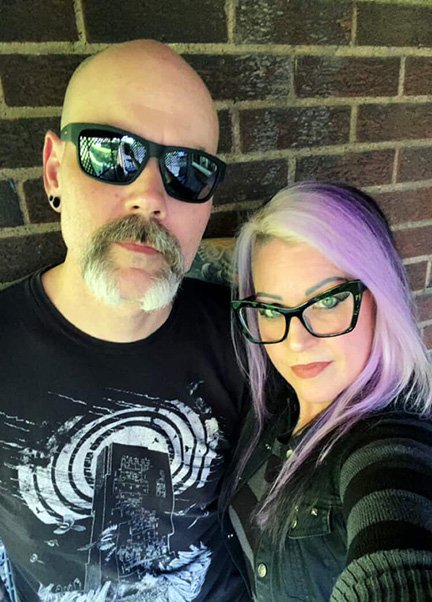Asanas from the Abyss: The Return of Black Yo)))ga
“I was like, ‘What the fuck is this? This is exactly what I want to use in my classes!’”
That was Kimee Massie, yoga instructor, holistic practitioner, and future co-founder of Black Yo)))ga, recalling the moment in 2012 when she first heard the German doom-jazz band Bohren und der Club of Gore while riding shotgun in her husband Scott’s car. It wasn’t chakra bells or spa-centre flute loops—it was something far heavier, more shadowed, and unmistakably hers. What she couldn’t have known then was that this passing moment of sonic resonance would ignite a movement—a slow, seismic ripple that would turn into a subcultural groundswell of breath, distortion, and release.
In the Western imagination, yoga often arrives prepackaged with airy New Age playlists, pastel colours, and walls adorned with slick photos of lithe yogis sandwiched between watered-down Sanskrit affirmations. For many, these are welcome signposts: beacons of calm, comfort, and spiritual intention. But for others, they’re barriers—like a saccharine force field of toxic positivity and overpriced crystals. While the yoga world prides itself on the refrain that “yoga is for everyone,” few have put that ideal to the test like Pittsburgh’s Black Yo)))ga. Forged in the gloaming of doom metal and trauma-informed healing, Black Yo)))ga shattered the mould, offering a wholly different vibe—an immersive style of yoga rooted in darkness, depth, and sweaty release—and in doing so, they have created a sanctuary for the misfits, the grieving, and the lost.
The notion that yoga classes could be taught with a heavy metal soundtrack was a revelation. From that fateful moment in the car, the duo went spelunking into the deeper caverns of sound. They created dark, consciousness-elevating playlists that Kimee would use in her classes, guiding students through yoga’s ancient poses while drone, doom and post metal pulsated through the room. Those early playlists showcased artists perched on metal’s gleaming knife edge. “We stuck with the staples, pretty much—sunn O))), Locrian, Wolves in the Throne Room, The Owls Are Not What They Seem, MGR...” recalls Scott. All conjurers of tension and atmosphere, this style of music offered something richer than ambience—it offered an invitation to go inward and downward. “It was doomy and dark and more my style,” Kimee says. “It brought a lot of men to the class,” she adds, laughing, “but really, people just hadn’t experienced anything like it before.” These were not tunes to stretch to while dreaming of oat milk lattes. They were dirges of descent. Heavy, slow, and elemental. “People would come up to us and say, ‘Fuck yeah! I never would have tried yoga before if you hadn’t offered it like this.’”
The buzz grew, first locally, then wider. Eventually, it wasn’t enough to just curate soundtracks for their classes—they wanted to compose them. The spark came when they began planning a DVD to capture the full sensory weight of the experience. The music posed a crucial choice: either license the work of others—a costly, bureaucratic slog—or compose something wholly their own, forged from the same instincts that had fuelled the practice from the start. It was a no-brainer. They’d already been adding creative touches to their class playlists. “In the very beginning, I was making these mixes with Chad Hammitt,” says Scott. “Even when we were just doing mixtapes, we were adding dynamics that would feed into Kimee’s flow. We didn’t want to just end one song and start another—it had to flow.”
Having scrapped the licensing labyrinth, they did what felt natural—they rolled out the mats, lit the candles, and let the yoga drag the music out of them like a séance with distortion pedals. “We’d do yoga in the studio before we made the music, so it was all very cohesive,” says Kimee. “Everybody involved were musicians and it made sense that this would be our next step.” What emerged was not background noise, but sonic architecture—compositions sculpted around the body, the breath, and the trauma that lives inside both.
Thus was born the Black Yo)))ga Meditation Ensemble—a rotating collective of Pittsburgh musicians built around Scott, Hammitt, and friends Nick DeMaio and Danielle Commisso. “In the beginning, it was just the four of us,” says Scott. “But over time we brought in others.” They would perform live while Kimee led the classes, the music ebbing and surging in tandem with breath and movement. “We feed off each other when we do it live,” she explains. “With the lights low and the sound vibrating across the floor, it becomes this immersive thing—really physical, really emotional.” The studio itself took on a sacred air. “The room is very dark and it’s lit only by candles,” says Kimee. “I want people to feel like they can let go without worrying who’s watching. If they’re going through something, I want them to go through it safely.” It was improvisational, primal, ritualistic. It was also, in Scott’s words, “the kind of thing we’d always talked about doing.”
And that’s Black Yo)))ga’s ethos; it was never conceived as some arty novelty. Kimee’s mission was always healing. When the pandemic sucker-punched the world, she doubled down—earning certifications in trauma-sensitive yoga, addiction recovery, and PTSD. “It’s very much a warrior’s-style yoga that goes deeper than just guiding you through the poses,” she says. She wasn’t teaching yoga for soccer mums and sun salutations. She was building a bunker for the broken. A place to exorcise demons, not decorate them with mandalas.
“A lot of people had been waiting for something like this,” says Scott. Kimee adds, “That’s why we put the sunn O))) in our logo, so people in the know would know.”
Scott and Kimee Massie
As a society, we’ve become allergic to resistance. If your job feels hard, ghost it. If your friend offends you, block them. If your phone dies, so do you. Everything is disposable. But yoga—real yoga—and meditation offer something radical: stay. Stay with the discomfort. With the boredom. With the ache. Black Yo)))ga is a place to stay and sweat and scream and sob. “I bring up a lot of darker shit that people stuff deep down inside for many years,” says Kimee. “They might have even forgotten about it, so I have to make them feel more comfortable so they can release it and let it go.” Crying in class is not uncommon. “I let people know ahead of time that some shit might come up, and if it does, don’t hold back—just let it go,” she says. “A lot of people have thanked me for that.” She adds, “I get a lot of the misfits—people who might not know how to get help and who might not have succeeded in other avenues.”
Their 2015 release Asanas Ritual, Vol. 1 and its accompanying DVD blew open the gates. Suddenly, metal yoga classes were cropping up like mushrooms after rain. But many missed the subterranean spirit of the original. “People who didn’t understand what we were doing assumed that (traditional metal) was the kind of thing we were doing—fast metal with vocals,” says Kimee. “But that wasn’t my intention at all. I was looking to create something on a much deeper level to help people heal mentally, physically, and emotionally. With all of those dark emotions that we tend to have that give power to addiction, suicide, and depression—that’s what I was focused on healing.” As she puts it plainly: “I wasn’t into throwing devil horns during class.” Scott, who trained as a yoga teacher not to teach but “to understand how to build a flow” and “write better music for it,” adds: “Make no mistake, we’ve done some stuff that’s really heavy and we can get loud and at times abrasive. And that’s intentional—sometimes that’s how you get through your shit.”
Then came the plague. The studio closed. The ensemble scattered. For four years, there was silence. But lately, the Massies have rekindled their enthusiasm, cautiously emerging from the crypt. Kimee is now teaching under her own name, while the Black Yo)))ga Meditation Ensemble prepares to rise again. “When things shut down around the pandemic,” says Scott, “we were kind of getting stressed out, trying to record all the time and do production, scheduling, editing. When you’ve got a lot of people involved, it can get really difficult and that’s what happened. I was happy to take some time off but I’m really happy to get back to doing this again. I think the meditation ensemble’s going to play a little bit more. We haven’t really defined anything, to be honest. We might perform just ourselves and we might perform as sort of performance art, with yoga happening while we’re doing it. I love those performances. That allows the audience to decide if they want to do yoga, or if they want to just watch the performance.”
Their first performance since the before-times will be on June 20, 2025, billed as at Death Comes Lifting presents: The RESURGENCE—a Summer Solstice ritual led by Kimee Massie and featuring live music from the Black Yo)))ga Meditation Ensemble. Held in Pittsburgh at Zak Bellante’s punk and metal-fuelled fitness sanctuary just a block from their old studio, the event blends yoga, doom, ritual, and community. While the in-person event sold out with head spinning brevity, a streaming presentation is being offered.
As for the future, the only plan is no plan. There might be more blended events—yoga and ritual sharing the same breath—or maybe not. Black Yo)))ga could re-emerge in full force, or perhaps it’s just the Meditation Ensemble moving forward, performing their sonic rites while others listen, stretch, or simply sit in the dark. Either way, they’re at peace with it. There’s a strange kind of comfort in the unknown—because that’s where the real work happens.
Kimee and Scott aren’t marketing visionaries or New Age influencers. They’re seekers—raw, weird, honest to the bone. They make music from the gut and live in the now, Which is the perfect place to be, because after all, that’s literally all there is.



